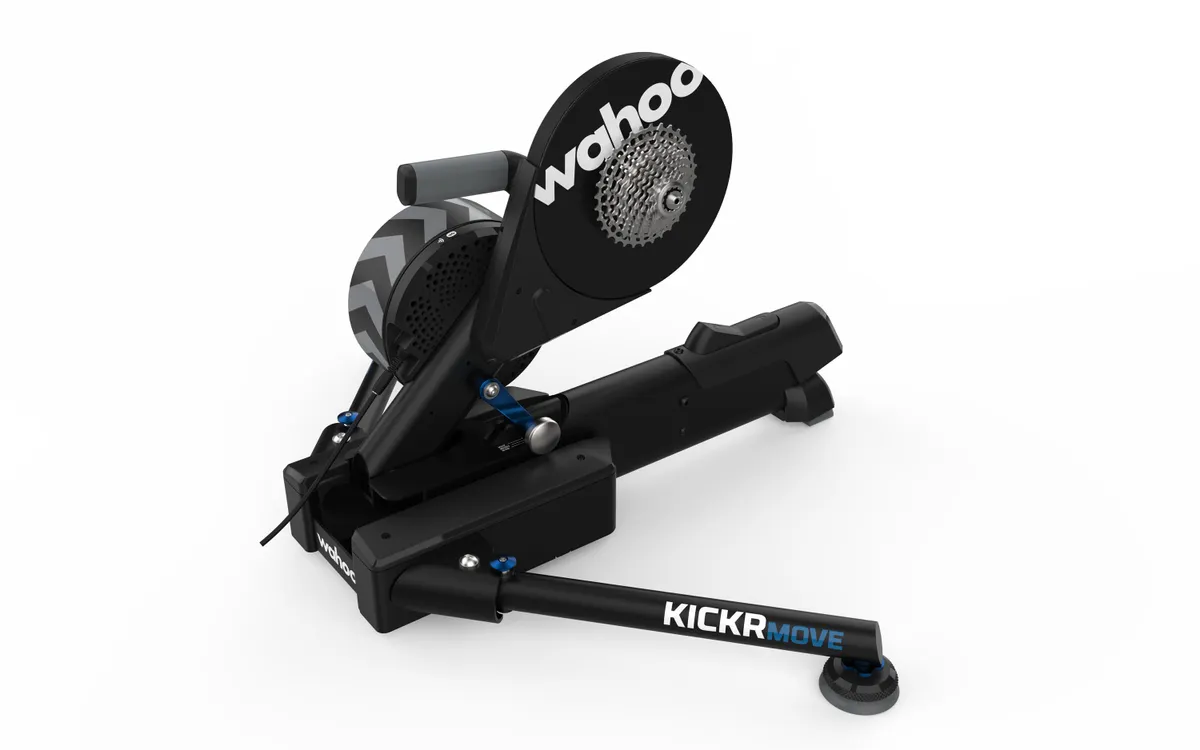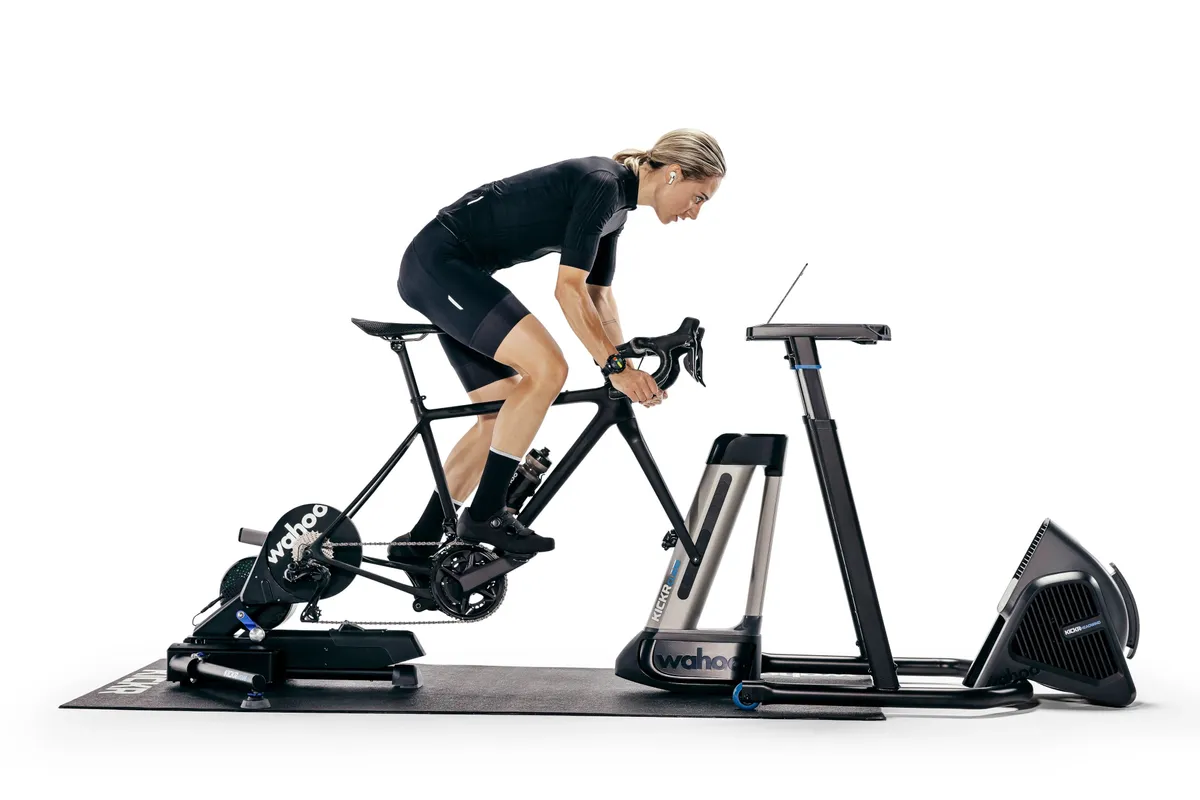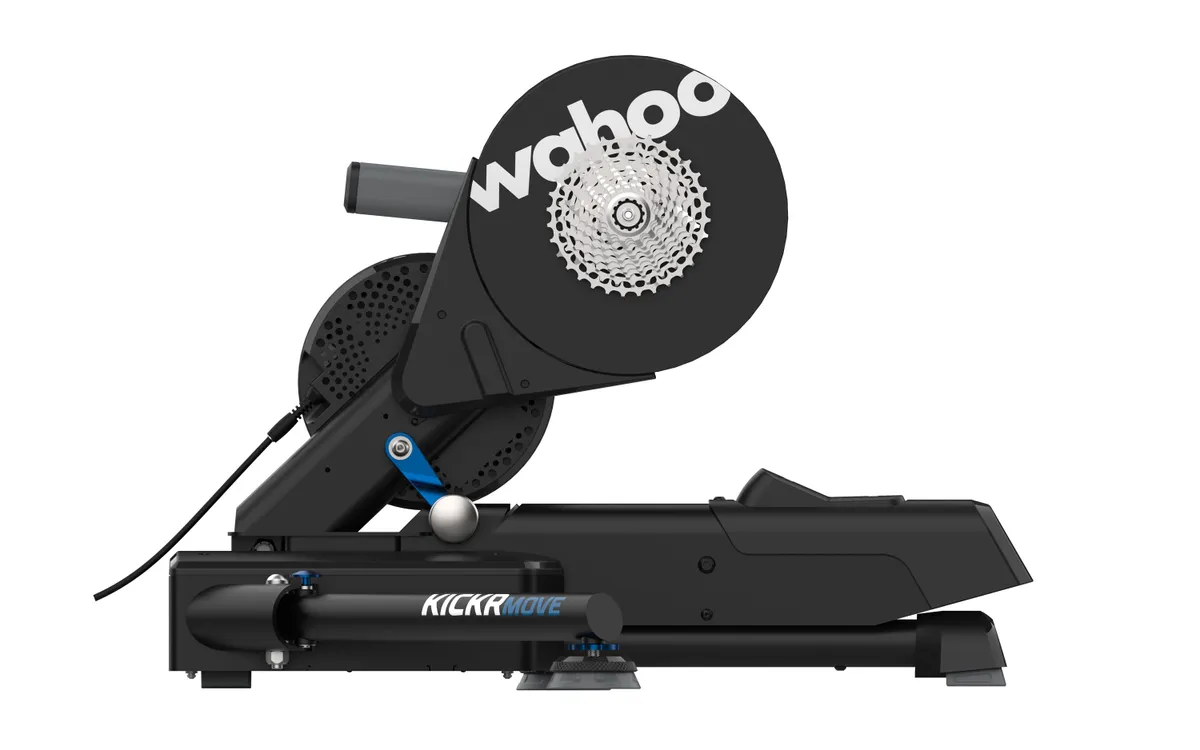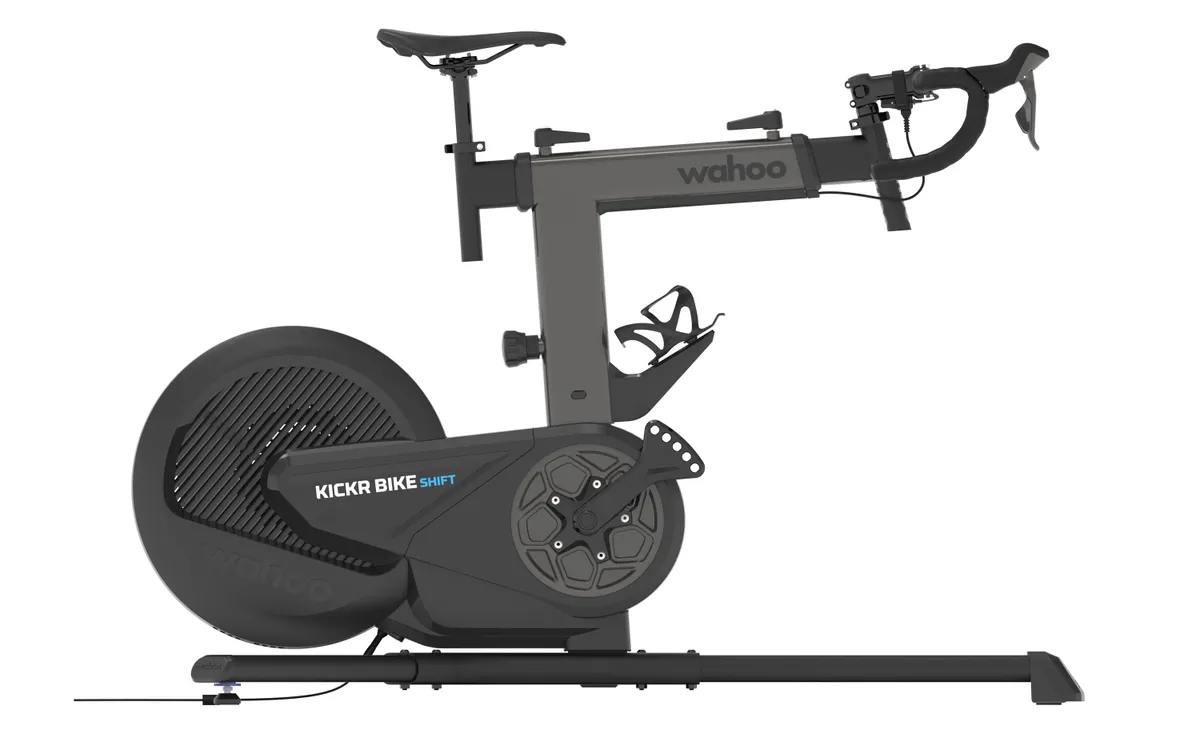Wahoo has announced the Kickr Move, an updated version of its highly-rated Kickr smart trainer that adds eight inches of fore-aft movement along an integrated track.
According to Wahoo, this results in a ride feel that is “remarkably similar” to riding outdoors, because the bike can move underneath you in a more natural way.
This is claimed to provide a more realistic, engaging and comfortable indoor cycling experience than ever before.
Priced at £1,399.99/$1,599.99/€1,599.99, the Wahoo Kickr Move costs £300/$300/€300 more than the existing Kickr V6 smart trainer (£1,099.99/$1,299.99/€1,299.99), which will remain part of Wahoo’s product catalogue.
Wahoo has also announced a new, cheaper version of its Kickr Bike indoor smart bike, the Kickr Bike Shift.
With an RRP of £2,699.99/$2,999.99/€2,999.99, the Kickr Bike Shift costs £800/$1,000/€1,000 less than the Kickr Bike V2, but – amongst other small changes – loses the ability to tilt to simulate gradients and features a modified brake and drivetrain system.
Move your body (and your bike)

As noted, the main innovation for the Kickr Move is the integration of a track that enables eight inches of fore-aft movement for the drive system and flywheel.
Wahoo says there's more side-to-side movement than with the Kickr V6, too.
As well as making the ride feel more realistic, Wahoo says this movement can reduce the fatigue typically associated with riding on a fixed trainer.

Due to the movement of the bike and front wheel induced by this, the Kickr Move precludes the use of accessories such as front-wheel riser blocks, or smart steering plates such as the Elite Sterzo Smart.
Wahoo has developed an adaptor to enable compatibility with its Kickr Climb accessory (a climb simulation device, which raises the front end of your bike via the axle in response to virtual gradient changes), however.

Movement mechanisms aside, the technical specs of the Kickr Move are largely identical to the Kickr V6.
This means it has the same 7.3kg flywheel and electromagnetic resistance system, the same claimed power accuracy of +/-1 per cent, and the same maximum power and simulated gradient of 2,200 watts and 20 per cent, respectively.
The Kickr Move also retains WiFi connectivity, enabling it to connect wirelessly to your local network.

This allows it to take advantage of Wahoo’s Race Mode feature, which enables the Kickr Move to transmit power data at a rate of 10Hz – 10 times faster than typically possible with ANT+ or Bluetooth (which most smart trainers use to send data at a rate of 1Hz).
Wahoo says this offers virtual racers, on platforms such as Zwift, Wahoo RGT or Rouvy, a competitive advantage, by enabling them to respond more quickly to competitors and changes of pace.
Is the Wahoo Kickr Move simply a smart trainer with an integrated rocker plate?

Wahoo says rocker plates – platforms that sit underneath your smart trainer and bike, and provide a degree of movement designed to replicate the feeling of riding outside – were an inspiration for the Kickr Move.
Tyler Harris, product manager at Wahoo, acknowledges rocker plates have benefits, but said the way they move underneath you doesn’t accurately replicate how riding a bike in the real world feels.
Of course, no indoor trainer will ever be able to replicate the fully immersive experience of outdoor cycling, but Harris feels the Kickr Move gets closer than any other smart trainer available.
He also pointed out rocker plates tend to raise a trainer and bike off the floor, making it more difficult to get on and off your bike.

In contrast, the Kickr Move doesn’t increase the height of your bike, and the movement mechanism can be locked off to ensure the bike doesn’t move unexpectedly while getting in or out of the saddle.
When asked why the Kickr Move has – movement aside – such similar specs to the Kickr V6 (which was also very similar to the Kickr V5 before it), Harris says the smart trainer market is reaching something of a technological plateau for high-end models.
This is clear to see in features such as power accuracy, flywheel size, maximum gradient and power output, noise, and so on – all of which have remained largely unchanged in recent-generation Kickr trainers.

That’s not to say there won’t be any further innovations from Wahoo in those areas, but Harris notes Wahoo could easily build a trainer with a 3,000-watt maximum power output – the issue is almost nobody wants or needs it.
Instead, Wahoo sees high-end smart trainers of the future addressing overlooked areas such as comfort and ride feel – two things which spurred the development of the Wahoo Kickr Rollr, and, now, the Kickr Move.
Why isn’t there a new Kickr Core?
With Wahoo having only released the Kickr V6 a year ago, some may have expected Wahoo to update its more value-focused direct-drive smart trainer, the Kickr Core, next.
When asked why Wahoo has opted to release another high-end smart trainer, Harris says “We [Wahoo] want to maintain our leading status of innovation”.
It’s also fair to say that despite being launched more than five years ago, the Kickr Core still offers the performance and specification to compete with the best smart trainers in its price bracket, such as the Zwift Hub, Elite Suito and Tacx Flux S.
Wahoo Kickr Bike Shift – an accessible indoor smart bike?

While it’s trying to bring new innovations to the high-end smart trainer market, Wahoo is also attempting to make smart indoor bikes more accessible with the Kickr Bike Shift.
As already noted, the Wahoo Kickr Bike Shift is around £800 or $/€1,000 cheaper than the Kickr Bike V2.
To hit this cheaper price, Wahoo has developed some new parts and systems, and used different materials in its construction. It has also cut back on some features compared to the Kickr Bike V2.

For a start, the Kickr Shift has a revised drivetrain and resistance system, with a new flywheel design.
According to Harris, the resistance system uses an electromagnetic brake with a large aluminium flywheel (which is encased within a plastic housing).
As a result of this new design, though, Wahoo says it was unable to give a “traditional weight measurement” for the flywheel.
The Kickr Shift also forgoes the motorised climb and descent simulation, meaning it can’t physically tilt up or down to simulate gradient changes. It can still use its electromagnetic brake to simulate resistance changes from virtual gradients, however.

The ability to use the customisable virtual drivetrain is retained, but the integrated LED display, which showed virtual gear and gradient information, is cut.
Wahoo says, however, that this information is broadcast by the Kickr Bike Shift and can be displayed by compatible apps, such as Wahoo RGT, and Wahoo bike computers.
Harris also says Wahoo is working with Zwift to enable this information to be displayed there too.
Lastly, the Kickr Bike Shift uses a steel rather than aluminium frame, which Wahoo says helps to cut costs.

Beyond these changes, though, the key specs are largely similar.
The Kickr Bike Shift has a +/- 1 per cent claimed power accuracy, a 2,200-watt maximum power and Wahoo says it can simulate gradients from -15 to +20 per cent.
It has a five-point adjustment system for dialling in your bike fit, with handlebar stack and reach, saddle height and setback, and frame height all highly customisable.
It also has WiFi, Bluetooth and ANT+ connectivity, but Wahoo says the Kickr Bike Shift doesn’t have the Race Mode function the Kickr Bike V2 and Kickr V6 have (which, as previously mentioned, transmits power data over WiFi at a higher sample rate).

Wahoo Kickr Move and Kickr Bike Shift pricing, specification and availability
The Wahoo Kickr Move and Kickr Bike Shift are available now.
As with previous Kickr trainers, the Wahoo Kickr Move will include an 11-speed, Shimano HG-compatible cassette.
Despite many of the latest mountain bike, gravel bike and road bike groupsets moving to 12-speed (or even 13-speed in some cases), Wahoo says 65 per cent of existing Wahoo Kickr owners use bikes with 11-speed drivetrains.
The brand says it will continue to monitor demand, however, and will consider updating this offering should the situation evolve.
Wahoo Kickr Move
- Price: £1,399.99/$1,599.99/€1,599.99
- Maximum power: 2,200 watts
- Claimed power accuracy: +/- 1 per cent
- Maximum simulated gradient: + 20 per cent
- Flywheel weight: 7.3kg
- Connectivity: WiFi, Bluetooth or ANT+
- Race Mode: Yes
- Claimed weight: 29kg
Wahoo Kickr Bike Shift
- Price: £2,699.99/$2,999.99/€2,999.99
- Maximum power: 2,200 watts
- Claimed power accuracy: +/- 1 per cent
- Maximum simulated gradient: + 20 per cent / - 15 per cent
- Flywheel weight: N/A
- Connectivity: WiFi, Bluetooth or ANT+
- Race Mode: No
- Claimed weight: 35.8kg



